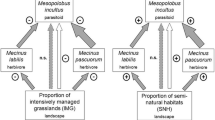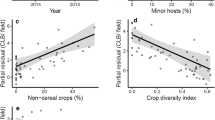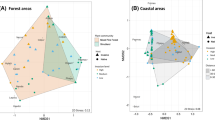Summary
In many plant communities, weeds are important drivers of ecosystem processes, but natural enemies may control their growth and population dynamics. These enemies may directly reduce plant growth by grazing or infection, or indirectly enhance plant susceptibility to other enemy species. The role of insects as vectors of plant pathogens has thereby often been underestimated but appears to be widespread and important. Crucial for the understanding of such plant–enemy interactions is the consideration of processes on local and regional scales. We analysed the effects of herbivore and pathogen attack and their interactions using the weed creeping thistle, Cirsium arvense, as a model system. Local thistle patches were limited by the thistles’ low competitive ability in secondary succession, by pathogens and insects and by the disturbance or management of habitats. The regional dynamics of C. arvense were mainly driven by human activities and showed a mosaic of increasing and decreasing local patches with low persistence. High patch turnover rates and subsequent small average patch sizes limited the success of herbivore populations.
Furthermore, we analysed thistle–herbivore–pathogen–parasitoid interactions on different spatial scales in a landscape context. Interactions between C. arvense and either insect herbivores or rust pathogens were related to landscape context at large spatial scales (3,000 m radius of landscape sector), whereas herbivore–parasitoid interactions were influenced at smaller scales (750 m). Hence, species at higher trophic levels appeared to have a smaller range of dispersal than those at lower levels. These marked spatial differences emphasize the need to consider both local and landscape management in biological control. In general, such an approach may help to explain the dynamics of plant populations in dependence on possible control by insects and pathogens which can affect the plants’ influence on ecosystem processes. However, the potential of facilitation among the plants’ antagonists via plant-mediated indirect interactions or with insects as vectors of pathogen spores and their dependence on species-specific spatial scales need much more experimental evidence.
Preview
Unable to display preview. Download preview PDF.
Similar content being viewed by others
References
Blossey B, Nötzold R (1995) Evolution of increased competitive ability in invasive non-indigenous plants: a hypothesis. J Ecol 83: 887–889
Brodmann PA, Wilcox CV, Harrison S (1997) Mobile parasitoid may restrict the spatial spread of an insect outbreak. J Anim Ecol 66: 65–72
Brown VK, Gange AC (1990) Insect-herbivory below-ground. Adv Ecol Res 20:1–58 Burdon JJ, Marshall DR (1981) Biological control and the reproductive mode of weeds. J Appl Ecol 18: 649–658
Chancellor RJ (1970) Biological background to the control of three perennial broad-leaved weeds. In: Proc 10th British Weed Control Conf, British Weed Control Council, London, pp 1114–1120
Cheplick GP, Clay K, Marks S (1989) Interactions between infection by endophytic fungi and nutrient limitation in the grasses Lolium perenne and Festuca arundinacea. New Phytol 111: 89–97
Coley PD, Bryant JP, Chapin FS (1985) Resource availability and plant antiherbivore defense. Science 230: 895–899
Crawley MJ (1989a) The relative importance of vertebrate and invertebrate herbivores in plant population dynamics. In: Bernays E (ed) Insect–plant interactions. CRC Press, Boca Raton, pp 45–71
Crawley MJ (1989b) The success and failures of weed biocontrol using insects. Biocontrol News Inf 10: 213–223
DeBach P (1964) Biological control of insect pests and weeds. Reinhold, New York
De Deyn GB, Raaijmakers CE, Zoomer HR, Berg MP, de Ruiter PC, Verhoef HA, Bezemer TM, van der Putten WH (2003) Soil invertebrate fauna enhances grassland succession and diversity. Nature 422: 711–713
Denys C, Tscharntke T (2002) Plant–insect communities and predator–prey ratios in field margin strips, adjacent crop fields, and fallows. Oecologia 130: 315–324
DeRuiter PC, Neutel AM, Moore JC (1995) Energetics, patterns of interaction strength, and stability in real ecosystems. Science 269: 1257–1260
Detling JK (1988) Grasslands and savannas: regulation of energy flow and nutrient cycling by herbivores. In: Pomeroy LR, Alberts JJ (eds) Concepts of entomology. Springer, Berlin Heidelberg New York, pp 131–148
Didham RK, Ghazoul J, Stork NE, Davis AJ (1996) Insects in fragmented forests: a functional approach. Trends Ecol Evol 11: 255–260
Dodd AP (1940) The biological control of prickly-pear in Australia. In: Whyte RO (ed) The control of weeds. Herbage Publ Ser Bull 27, Imperial Bureau of Pastures and Forage Crops, Aberystwyth, pp 131–143
Donald WW (1994) The biology of Canada thistle (Cirsium arvense). Rev Weed Sci 6:77– 101
Dunne JA, Williams RJ, Martinez ND (2002) Network structure and biodiversity loss in food webs: robustness increases with connectance. Ecol Lett 5: 558–567
Dyer LA, Letourneau D (2003) Top-down and bottom-up diversity cascades in detrital vs. living food webs. Ecol Lett 6: 60–68
Eber S, Brandl R (1994) Ecological and genetic spatial patterns of Urophora cardui ( Diptera: Tephritidae) as evidence for population structure and biogeographical processes. J Anim Ecol 63: 187–199
Eber S, Brandl R (1996) Metapopulation dynamics of the tephritid fly Urophora cardui: an evaluation of incidence-function model assumptions with field data. J Anim Ecol 65: 621–630
Eber S, Brandl R (2003) Regional patch dynamics of the weed Cirsium arvense, and possible implications for plant animal interactions. J Veg Sci 14: 259–266
Ettema CH, Wardle DA (2002) Spatial soil ecology. Trends Ecol Evol 17: 177–183
Faeth SH, Bultman T (2002) Endophytic fungi and interactions among host plants, herbivores, and natural enemies. In: Tscharntke T, Hawkins BA (eds) Multitrophic level interactions. Cambridge University Press, Cambridge, pp 89–123
Frantzen J (1994a) An epidemiological study of Puccinia punctiformis (Str.) Röhl as a stepping stone to the biological control of Cirsium arvense (L.) Scop. New Phytol 127: 147–154
Frantzen J (1994b) The role of clonal growth in the pathosystem Cirsium arvense–Puccinia punctiformis. Can J Bot 72: 832–836
Frantzen J, Van der Zweerde W (1994) Quantitative resistance of Cirsium arvense to root bud infection by Puccinia punctiformis. Biocontrol Sci Tech 4: 223–228
Friedli J, Bacher S (2001a) Mutualistic interaction between a weevil and a rust fungus, two parasites of the weed Cirsium arvense. Oecologia 129: 571–576
Friedli J, Bacher S (2001b) Direct and indirect effects of a shoot-base boring weevil and plant competition on the performance of creeping thistle, Cirsium arvense. Biol Control 22: 219–226
Gange AC, Brown VK (eds) (1997) Multitrophic level interactions in terrestrial systems. In: Proc 36th Symp of the British Ecological Society, Blackwell Science, Oxford
Gliessman SR, Garcia ER, Amador AM (198 1) The ecological basis for the application of traditional agricultural technology in the management of tropical agro-ecosystems. Agro-ecosystems 7: 173–185
Gordon DR (1998) Effects of invasive, non-indigenous plant-species on ecosystem processes: lessons from Florida. Ecol Appl 8: 975–989
Gremmen NJM, Chown SL, Marshall DJ (1998) Impact of the introduced grass Agrostis stolonifera on vegetation and soil fauna communities at Marion Island, sub-Antarctic. Biol Cons 85: 223–231
Guske S, Boyle C, Schulz B (1996) New aspects concerning biological control of Cirsium arvense. IOBC WPRS Bull 19: 281–290
Hairston NG, Smith FE, Slobodkin LB (1960) Community structure, population control, and competition.Am Nat 94: 421–425
Hassell MP (2000) The spatial and temporal dynamics of host–parasitoid interactions. Oxford University Press, London
Hatcher PE (1995) Three-way interactions between plant pathogenic fungi, herbivorous insects and their host plants. Biol Rev 70: 639–694
Hatcher PE, Paul ND (2001) Plant pathogen–herbivore interactions and their effects on weeds. In: Jeger MJ, Spence NJ (eds) Biotic interactions in plant–pathogen associations. CAB International, Wallingford, pp 193–226
Hegi G (1987) Illustrierte Flora von Mitteleuropa. Band VI, Teil 4. Paul Parey, Berlin Heimann B, Cussans GW (1996) The importance of seeds and sexual reproduction in the population biology of Cirsium arvense–a literature review. Weed Res 36: 493–503
Hoffmann GM, Nienhaus F, Poehling H-M, Schönbeck F, Weltzien HC, Wilbert H (1994) Lehrbuch der Phytomedizin. 3. Auflage. Blackwell, Berlin
Holm LG, Plucknett DL, Pancho JV, Herberger JP (1977) The world’s worst weeds. Distribution and biology. University Press of Hawaii, Honolulu
Holt RD, Lawton JH, Polis GA, Martinez ND (1999) Trophic rank and the species-area relationship. Ecology 80: 1495–1504
Hulme PE (1996) Herbivores and the performance of grassland plants: a comparison of arthropod, mollusc and rodent herbivory. J Ecol 84: 43–51
Jeltsch F, Wissel C, Eber S, Brandl R (1992) Oscillating dispersal patterns of tephritid fly populations. Ecol Mod 69: 53–75
Jules ES, Kauffman MK, Ritts WD, Carroll AL (2002) Spread of an invasive pathogen over a variable landscape: a nonnative root rot on Port Orford cedar. Ecology 83: 3167–3181
Kareiva P, Wennergren U (1995) Connecting landscape patterns to ecosystem and population processes. Nature 373: 299–302
Keane RM, Crawley (2002) Exotic plant invasions and the enemy release hypothesis. Trends Ecol Evol 17: 164–170
Klironomos JN (2002) Feedback with soil biota contributes to plant rarity and invasiveness in communities. Nature 417: 67–70
Kluth S, Kruess A, Tscharntke T (2001) Interactions between the rust fungus Puccinia punctiformis and ectophagous and endophagous insects on creeping thistle. J Appl Ecol 38: 548–556
Kluth S, Kruess A, Tscharntke T (2002) Insects as vectors of plant pathogens: mutualistic and antagonistic interactions. Oecologia 133: 193–199
Kluth S, Kruess A, Tscharntke T (2003) Influence of pathogen application and cutting on the performance and nutrient storage of Cirsium arvense. J Appl Ecol 40: 334–343
Kruess A (2002) Indirect interaction between a fungal plant pathogen and a herbivorous beetle of the weed Cirsium arvense. Oecologia 130: 563–569
Kruess A (2003a) Effects of landscape structure and habitat type on a plant–herbivore–parasitoid community. Ecography 26: 283–290
Kruess A (2003b) Effects of landscape and habitat type on potential biological control agents against creeping thistle and their natural enemies. IOBC WPRS Bull 26(4):83– 88
Kruess A, Tscharntke T (1994) Habitat fragmentation, species loss, and biological control. Science 264: 1581–1584
Kruess A, Tscharntke T (2000) Effects of habitat fragmentation on plant–insect communities. In: Ekbom B, Irvin ME, Robert Y (eds) Interchanges of insects between agricultural and surrounding landscapes. Kluwer, Dordrecht, pp 53–70
Leibold MA (1996) a graphical model of keystone predators in food webs: trophic regulation of abundance, incidence, and diversity patterns in communities. Am Nat 147:784–812
Maron JL, Harrison S (1997) Spatial pattern formation in an insect host–parasitoid system. Science 278: 1619–1621
Marshall EJP, Brown VK, Boatman ND, Lutman PJW, Squire GR, Ward LK (2003) The role of weeds in supporting biological diversity within crop fields. Weed Res 43: 77–89
Masters GJ, Brown VK (1997) Host-plant mediated interactions between spatially separated herbivores: effects on community structure. In: Gange AC, Brown VK (eds) Multitrophic interactions in terrestrial systems. Blackwell, Oxford, pp 217–237
McClay AS, Bourchier RS, Butts RA, Peschken DP (2001) Cirsium arvense. In: Mason PG, Huber JT (eds) Biological control programmes in Canada 1981–2000. CAB International, Wallingford, pp 318–330
McNaughton SJ (1983) Compensatory plant growth as a response to herbivory. Oikos 40: 329–336
Moore RJ (1975) The biology of Canadian weeds. 13. Cirsium arvense (L.) Scop. Can J Plant Sci 55: 1033–1048
Mortimer SR, Van der Putten WH, Brown VK (1999) Insect and nematode herbivory below-ground: interactions and role in vegetation development. In: Olff H, Brown VK, Drent RH (eds) Herbivores: between plants and predators. Blackwell, Oxford, pp 205– 238
Mulder CPH, Koricheva J, Huss-Danell K, Hogberg P, Joshi J (1999) Insects affect relationships between plant species richness and ecosystem processes. Ecol Lett 2: 237–246
Müller-Schärer H, Scheepens PC (1997) Biological control of weed in crops: a coordinated European research programme (COST 816). Integrated Pest Manage Rev 2: 1–6
Müller-Schärer H, Scheepens PC, Greaves MP (2000) Biological control of weeds in European crops: recent achievements and future work. Weed Res 1: 83–98
Oksanen L, Fretwell SD, Arruda J, Niemela P (1981) Exploitation ecosystems in gradients of primary productivity.Am Nat 118: 240–261
Östman Ö, Ekbom B, Bengtsson J (2001) Landscape complexity and farming practice influence the condition of polyphagous carabid beetles. Ecol Appl 11: 480–488
Owen DF, Wiegert RD (1976) Do consumers maximize plant fitness? Oikos 27: 488–492
Persson L (1999) Trophic cascades: abiding heterogeneity and the trophic level concept at the end of the road. Oikos 85: 385–397
Peschken DP (1981) Biological control of Canada thistle. Proc N Cent Weed Conf 36: 169–173
Peschken DP (1984) Cirsium arvense (L.) Scop., Canada thistle (Compositae). In: Kelleher JS, Hulme MA (eds) Biological control programmes against insects and weeds in Canada 1969–1980. Commonwealth Agricultural Bureau, Slough, pp 139–146
Roland J, Taylor PD (1995) Herbivore–natural enemy interactions in fragmented and continuous forests. In: Cappucino N, Price PW (eds) Population dynamics: new approaches and synthesis. Academic Press, San Diego, pp 195–208
Roland J, Taylor PD (1997) Insect parasitoid species respond to forest structure at different spatial scales. Nature 386: 710–713
Root RB (1973) Organization of a plant–arthropod association in simple and diverse habitats: the fauna of collards (Brassica oleracea). Ecol Monogr 43: 95–125
Schmitz OJ, Hambäck PA, Beckerman AP (2000) Trophic cascades in terrestrial ecosystems: a review of the effects of carnivore removal on plants.Am Nat 155: 141–153
Schroeder D (1980) The biological control of thistles. Biocontrol News Inf 1: 9–26
Schroeder D, Müller-Schärer H, Stinson CSA (1993) A European weed survey in 10 major crop systems to identify targets for biological control. Weed Res 33: 449–458
Seitz A, Komma M (1984) Genetic polymorphism and its ecological background in tephritid populations (Diptera: Tephritidae). In: Wöhrmann K, Löschke V (eds) Population biology and evolution. Springer, Berlin Heidelberg New York, pp 143–158
Siegel MR (1993) Acremonium endophytes: our current state of knowledge and future directions for research. Agric Ecosyst Environ 44:301–321
Skinner K, Smith L, Rice P (2000) Using noxious weed lists to prioritize targets for developing weed management strategies. Weed Sci 48: 640–644
Steffan-Dewenter I, Münzenberg U, Bürger C, Thies C, Tscharntke T (2002) Scale-depen- dent effects of landscape context on three pollinator guilds. Ecology 83: 1421–1432
Steiner WE (1984) A review of the biology of the phalcrid beetles. In: Wheeler Q, Blackwell M (eds) Fungus–insect relationships, perspectives in ecology and evolution. Columbia University Press, New York, pp 424–445
Thies C, Tscharntke T (1999) Landscape structure and biological control in agroecosystems. Science 285: 893–895
Thies C, Steffan-Dewenter I, Tscharntke T (2003) Effects of landscape context on herbivory and parasitism at different spatial scales. Oikos 101: 18–25
Thompson K, Bakker JP, Bekker RM (1997) The soil seed banks of north west Europe: methodology, density and longevity. Cambridge University Press, Cambridge Trumble JT, Kolodny-Hirsch DM, Ting IP (1993) Plant compensation for arthropod herbivory. Annu Rev Entomol 38: 93–119
Tscharntke T, Hawkins BA (2002) Multitrophic level interactions. Cambridge University Press, Cambridge
Tscharntke T, Kruess A (1999) Habitat fragmentation and biological control. In: Hawkins BA, Cornell HV (eds) Theoretical approaches to biological control. Cambridge University Press, Cambridge, pp 190–205
Van der Putten WH (1999) Interactions of plants, soil pathogens and their antagonists in natural ecosystems. In: Jeger MJ, Spence NJ (eds) Biotic interactions in plant pathogen associations. CAB International, Wallingford, pp 285–305
Van der Putten WH, Vet LEM, Harvey JA, Wäckers FL (2001) Linking above-and below-ground multitrophic interactions of plants, herbivores, pathogens, and their antagonists. Trends Ecol Evol 16: 547–554
Vitousek PM (1986) Biological invasions and ecosystem properties: can species make a difference? In: Mooney HA, Drake JA (eds) Ecology of biological invasions of North America and Hawaii. Ecological Studies 58. Springer, Berlin Heidelberg New York, pp 163–176
Vitousek PM, Walker LR (1989) Biological invasions by Myrica faya in Hawaii: plant demography, nitrogen fixation, ecosystem effects. Ecol Monogr 59: 247–265
Völker K, Boyle C (1994) Bean rust as a model system to evaluate efficiency of teliospore induction, especially in the potential mycoherbicide Puccinia punctiformis. Weed Res 34: 275–281
Wardle DA (ed) (2002) Communities and ecosystems: linking the aboveground and belowground components. Princeton University Press, Princeton, NJ
Watson AK, Keogh WJ (1980) Mortality of Canada thistle due to Puccinia punctiformis. In: Delfosse ES (ed) Proc 5th Int Symp on Biological Control of Weeds, Brisbane, CSIRO, Melbourne, pp 325–332
Watt AS (1947) Pattern and process in the plant community. J Ecol 35: 1–22
Whittaker RH (1953) A consideration of climax theory: the climax as a population and pattern. Ecol Monogr 23: 41–78
Wiegand T, Molony KA, Naves J, Knauer F (1999) Finding the missing link between landscape structure and population dynamics: a spatially explicit perspective. Am Nat 154: 605–627
Wilby A, Brown VK (2001) Herbivory, litter and soil disturbance as determinants of vegetation dynamics during early old-field succession under set-aside. Oecologia 127: 259–265
Wilcove DS, Rothstein D, Dubow J, Phillips A, Losos E (1998) Quantifying threats to imperiled species in the United States. Bioscience 48: 607–615
Wilson CL (1969) Use of plant pathogens in weed control. Annu Rev Phytopath 7:411– 434
With KA, Gardner RH, Turner MG (1997) Landscape connectivity and population distributions in heterogeneous environments. Oikos 78: 151–169
Editor information
Editors and Affiliations
Rights and permissions
Copyright information
© 2008 Springer-Verlag Berlin Heidelberg
About this chapter
Cite this chapter
Kruess, A., Eber, S., Kluth, S., Tscharntke, T. (2008). Plant-Insect-Pathogen Interactions on Local and Regional Scales. In: Weisser, W.W., Siemann, E. (eds) Insects and Ecosystem Function. Ecological Studies, vol 173. Springer, Berlin, Heidelberg. https://doi.org/10.1007/978-3-540-74004-9_8
Download citation
DOI: https://doi.org/10.1007/978-3-540-74004-9_8
Publisher Name: Springer, Berlin, Heidelberg
Print ISBN: 978-3-540-74003-2
Online ISBN: 978-3-540-74004-9
eBook Packages: Biomedical and Life SciencesBiomedical and Life Sciences (R0)




